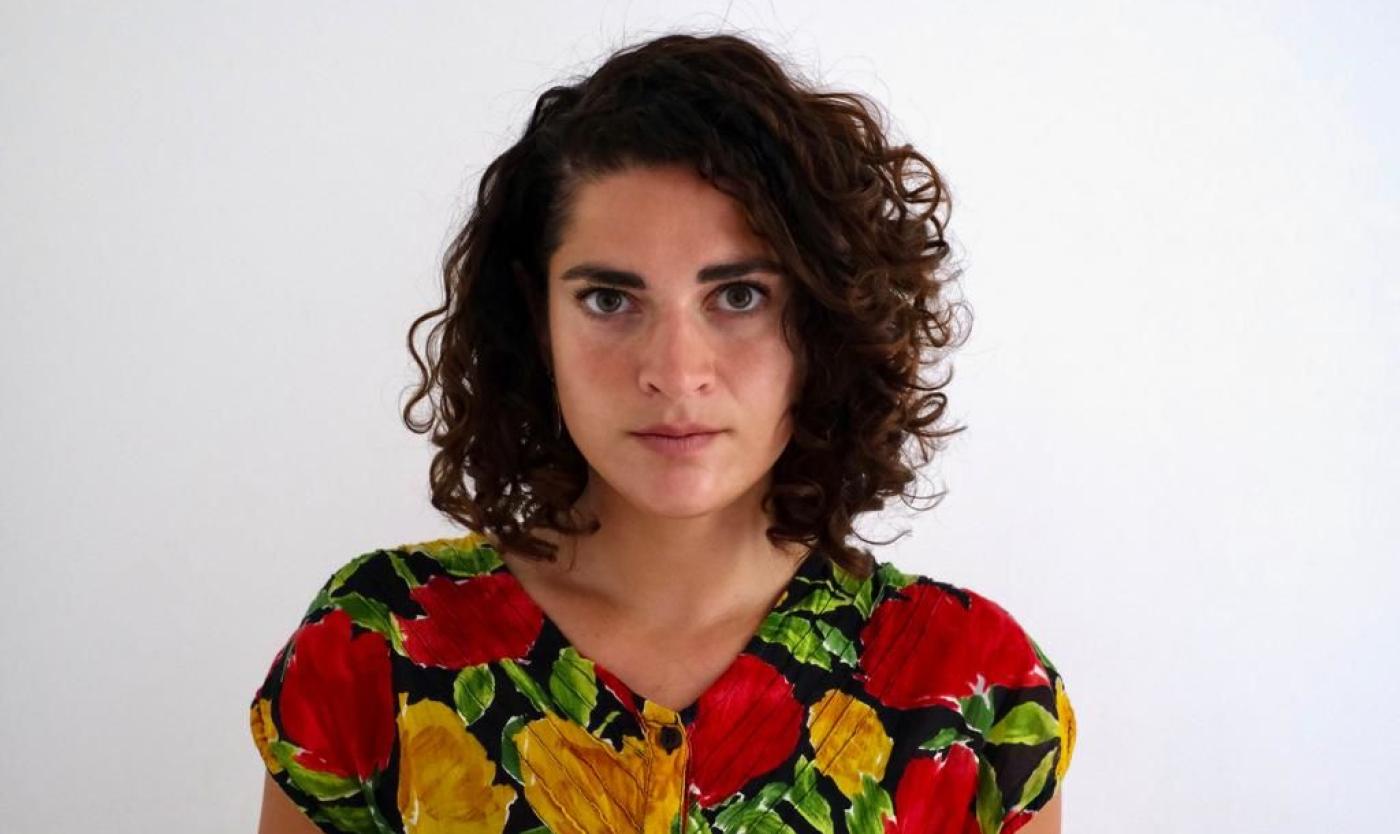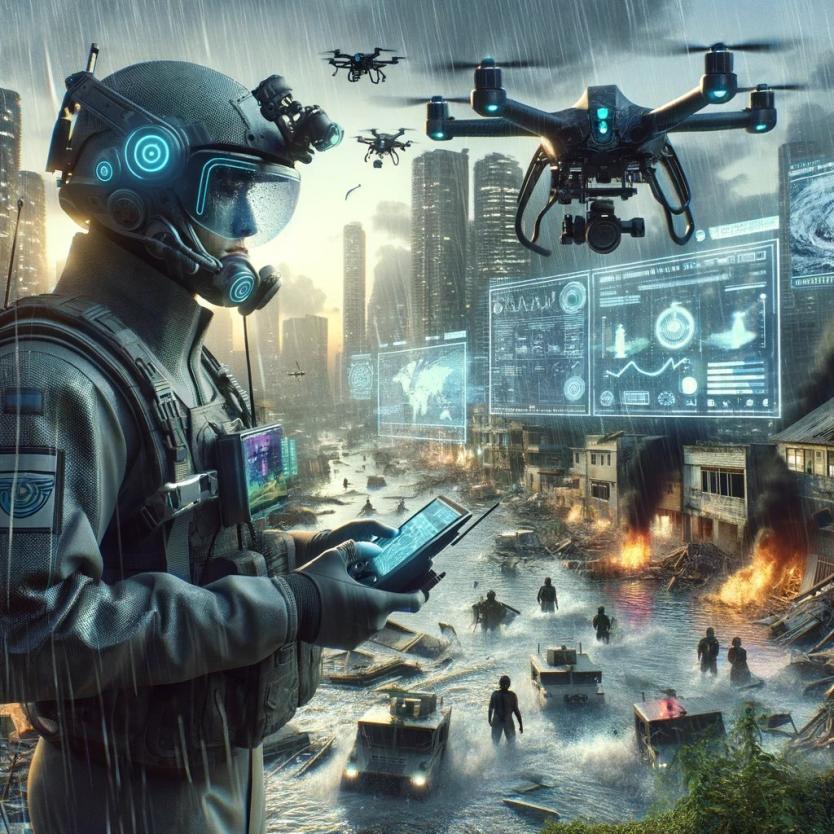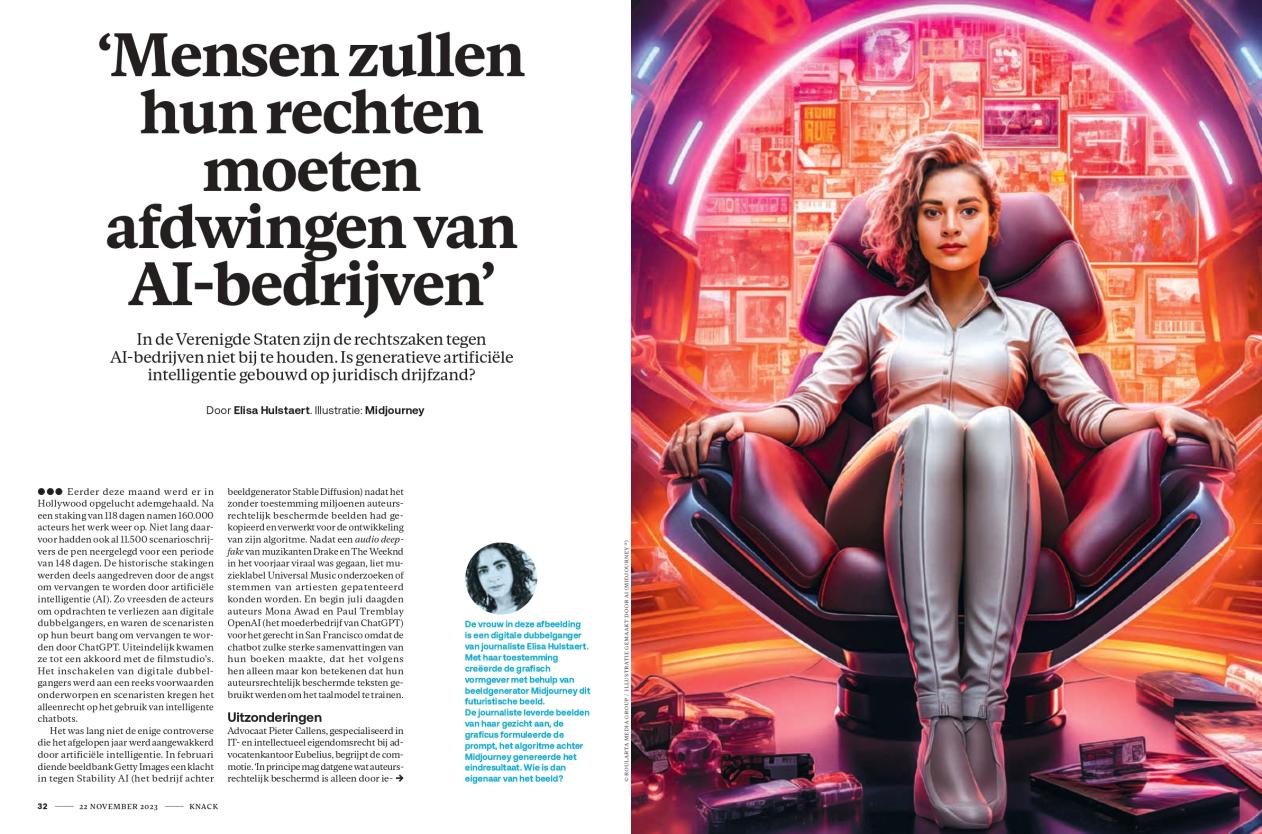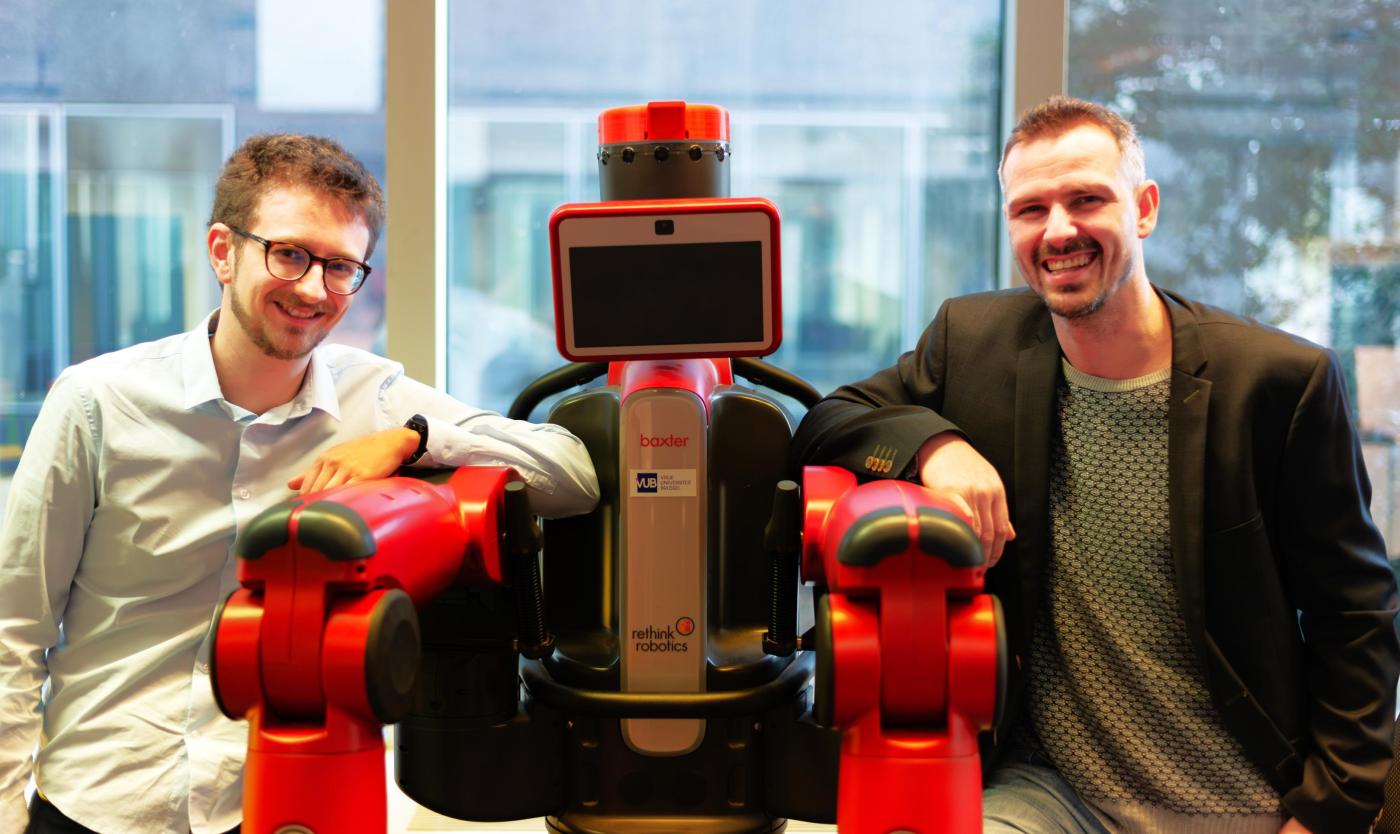
Research, fact-checking, summarising, transcribing, translating... the media are eagerly experimenting with what AI can do. But can these new, miraculous tools really align with the core mission of journalism: to deliver unbiased, truthful and transparent news? And how many human journalists will remain once the AI revolution is complete? The answer from Knack journalist and VUB alumna Elisa Hulstaert is not entirely reassuring. “We will always need people. Just fewer of them, I fear.”
AI in Journalism: Revolutionary Aid or Virtual Replacement? This is the topic that media experts will debate on 21 March at VUB. Attendees include publishers and editors from outlets like De Tijd, De Standaard, Knack and VRT NWS, as well as Christian Van Thillo of DPG Media and Flemish Media minister Benjamin Dalle. Some big hitters, then. It’s an important subject, as artificial intelligence could push the media world – already struggling with competition from social media and declining circulations and ad revenue – into the perfect storm.
Before we descend into doom and gloom, we should say that AI can also be good for journalism. And progress is surprisingly swift. Elisa Hulstaert has been writing for Knack for two years, mainly on artificial intelligence. In that short time, AI tools have significantly altered the editorial workflow, she says. “Roularta, our publisher, even employs an AI expert. Because she has journalistic experience, she understands what a newsroom needs. She tests AI tools herself before deploying them on the editorial floor. Then, if the feedback is positive, we might invest in a subscription.”

““AI converts long interviews into text at lightning speed”
Which AI tool has made your life easier?
“Transcription software. It converts voice files into text. I’ve always loathed transcribing lengthy interviews; it’s boring and time-consuming. Speech-to-text software does the job in no time. Because Dutch is a less common language, it took a while for decent tools to emerge, like Good Tape and Sonix. They’ve come on in leaps and bounds in the last year.”
What brand do you use?
“We’ve just subscribed to Limecraft. This week I tried it for the first time and was pleasantly surprised. My interview of over two hours was converted into 41 pages of Word in just 10 minutes. While the conversation is still fresh in my memory, I highlight the relevant parts in yellow. And I double-check the figures. I write those down during the interview, as the tool can easily get them wrong.”
But you can’t just use that output as it is, right?
“Absolutely not! People don’t speak in perfect sentences. They leave thoughts unfinished, digress, add something to what they said a quarter of an hour before. It’s up to the journalist to bring structure, extract the essence and articulate everything clearly… So there’s still work to be done. Editors and publishers must not think that an article will be finished twice as fast thanks to transcription software.”
Can the transcription software handle the richness of Flemish dialects and accents? Can it tell the difference between hoed and goed?
“That’s also improving. With a West Flemish interviewee, it might confuse a ‘g’ and an ‘h’, but that’s quickly corrected.”
What other AI tools do you use?
“Translation software. If I conduct an interview in English, I can have it transcribed by Limecraft and immediately translated into Dutch by DeepL, which is integrated into the system. You need to remove all the errors from the transcription first, or they’ll just be translated too.”
What about articles that Knack takes from foreign magazines?
“We used to translate them with DeepL until recently. A sub-editor would then go through it because the Dutch was sometimes a bit rough. Lately, we’re increasingly using ChatGPT, followed by a human check. That currently gives the best results. The advantage of ChatGPT is that you can play with the prompts – the instructions you give the tool. For example, you can specify that the translation is for a news magazine and should therefore have a certain authority. That way you get the right tone. These prompts are also interesting for teachers. They can take a complex article from Knack and ask the tool to rewrite it for 12-year-olds.”
What else do you use ChatGPT for?
“Sometimes I have it formulate possible interview questions. I don’t take them verbatim, but they can inspire me. It helps you step outside your own frame of reference. ChatGPT is also a handy writing aid. You can ask for an outline for your article, with a possible order for the topics that you’ll cover. Suggestions for headlines and introductions are also possible. If you’re not worried about copyright and intellectual property, you can even upload your article and ask it to add a five-sentence introduction at the start.”

Deze afbeelding werd gegenereerd via ChatGPT Dall-e
“Just to be clear: I still do the writing myself”
So no more fear of the blank page!
“Absolutely. But just to be clear: I still do the writing myself.” (laughs)
Do you also use AI as a search engine?
“For a neatly delineated piece of text, I’d let a tool search for specific information, or write a summary. But you have to be careful with what’s online. ChatGPT is programmed to always give you an answer. If it can’t find anything, it starts ‘hallucinating’ and making things up. The same goes for the transcription software we mentioned. If it doesn’t understand a word properly, it’ll still make an attempt. You can ask some tools to highlight the words that they’re sure about in green and the uncertain ones in red.”
What do you consider a reliable AI search engine?
“The chat function of Bing. When it answers a query, it underlines certain sentences and tells you where the information comes from. For journalists, this attribution is vital: you can verify if the source is reliable. Perplexity.ai also cites sources. What I particularly appreciate about Perplexity is its candour; if it doesn’t find the information, it just tells you. That modesty inspires confidence.”

Deze afbeelding verscheen in Knack
Are AI tools redrawing illustrations too?
“Some colleagues from the design department have trained with Midjourney. It’s an image generator that, using vast datasets and user prompts, creates new illustrations or photos. A case in point: for an article I wrote on intellectual property, they used a handful of photos to create a futuristic version of me. I found it particularly striking.”
You don’t really have pink hair, do you?
“No!” (laughs) “And I’m less fierce-looking too.”
So, what an illustrator might labour over for a day, an image generator can create in a moment. And there’s no need for a studio, either
“Illustrations are a significant expense for newsrooms, so this indeed represents a saving. Regrettably so. The output looks great, but you lack the artist’s hand and emotion.”
Will AI result in job losses?
“We will always need people. Just fewer of them, I fear. The job is going to change radically. Journalists who are comfortable with AI tools will have a competitive edge. And yet... The United States recently saw the launch of Channel1.ai: a fully AI-generated news channel. Even the anchors are AI creations, and with a simple click you can change to a different face, voice and language. If this is the future, I find it rather daunting.”
“AI is trained on data that’s white, Western and male”
Is the bias of AI a cause for concern?
“AI tools are fed with data from the internet, and the internet isn’t neutral. ChatGPT, for instance, was trained on Reddit. The discussion forums on this social media platform are predominantly inhabited by white, Western men aged 25-35. Silicon Valley, for the most part, is also white, Western and male. There’s an interesting chart showing where AI predominantly draws its data from: North America, Europe and Australia. There’s no guarantee that these new AI tools are presenting the world in a representative way, given the non-representative nature of the data they learn from.”
And the results?
“Ask an image generator to depict a person from Mexico, and you’re likely to get a man with a moustache, a poncho and a sombrero. BuzzFeed once used AI to create a Barbie doll for each country. A bit awkward: the Barbie from South Sudan was holding a gun.”
BIO: Elisa Hulstaert is an AI expert and VUB alumna
Elisa Hulstaert studied linguistics and literature and worked in communications for 10 years. Three years ago, she took a sabbatical to pursue a master’s in journalism at VUB. After an internship at Knack, she continued as an AI specialist. At the debate on 21 March, she will comment alongside two other experts.
VUB lecturer Frederik Marain on AI in journalism training
“Lecturers and students should create a responsible AI culture together”
As part of the Master’s in Journalism, AI appears in the module on advanced journalistic techniques, taught by Frederik Marain. What does he see as the most important AI-related skill that would-be journalists should have? “Learning which tool to use for which kind of research. Essentially, that means: look up basic facts on Wikipedia and links via Google. Use AI tools like ChatCPT for more analytical searches: comparisons, summaries, things that are hard to find with a single Google search… Students need to understand that AI tools are not factual search engines but simply statistical machines that have read a lot. So they need a healthy amount of distrust.”
In education, AI is a joint voyage of discovery for lecturers and students, with new ethical obstacles to negotiate. Students on a deadline might think of using ChatGPT as an instant and willing scribe. Copy, paste, go. “The result is usually… average. It feels as if it was written by AI. That’s why I encourage students not to use ChatGPT as an easy shortcut but as a way to become a better writer. First write your article or essay yourself, then ask ChatGPT to review the text and give you some tips to improve it. Or use it to come up with angles, interview questions or ideas for articles.”
Having ChatGPT write a text and presenting it as your own work is not OK. But how can you deal with that? Sanctions are very difficult, says Marain. “There are tools that can spot dishonest use of AI, but they don’t give you 100% certainty. That’s why I want students to approach it differently: let’s work together to come up with an AI culture tailored to our course, where we use these new tools in a responsible and ethical way. I think every faculty should do this, because AI is different everywhere it’s used. If we don’t do it, then there will soon be rules introduced university-wide. That seems unworkable to me, if only because it’s so hard to prove that someone has used AI.”
The world needs you
This initiative is part of the public programme of VUB: a programme for everyone who believes that scientific knowledge sharing, critical thinking and dialogue are an important first step to create impact in the world.
As an Urban Engaged University, VUB aims to be a driver of change in the world. With our academic edcuational programmes and innovative research, we contribute to the Sustainable Development Goals of the United Nations and to making a difference locally and globally.


